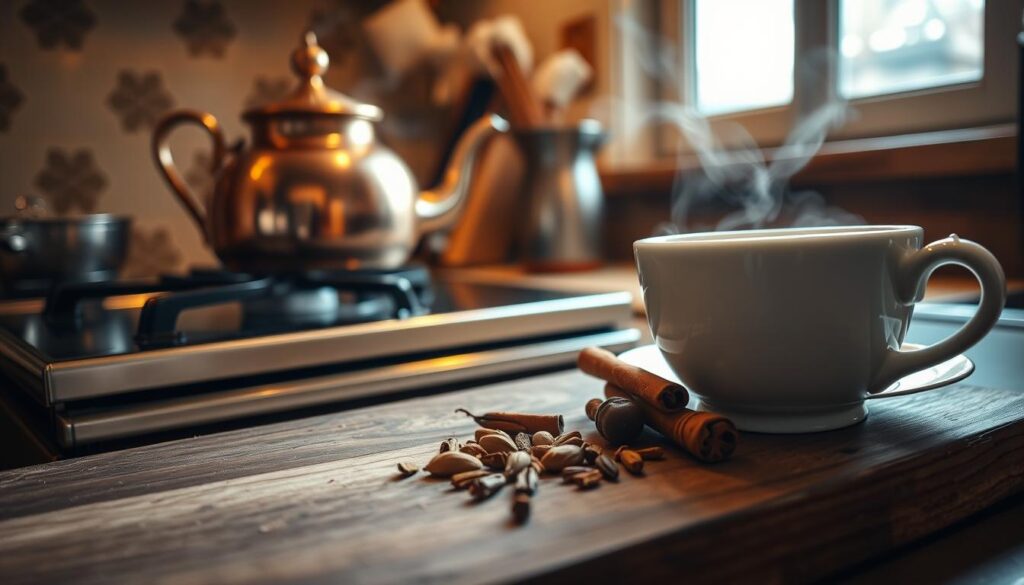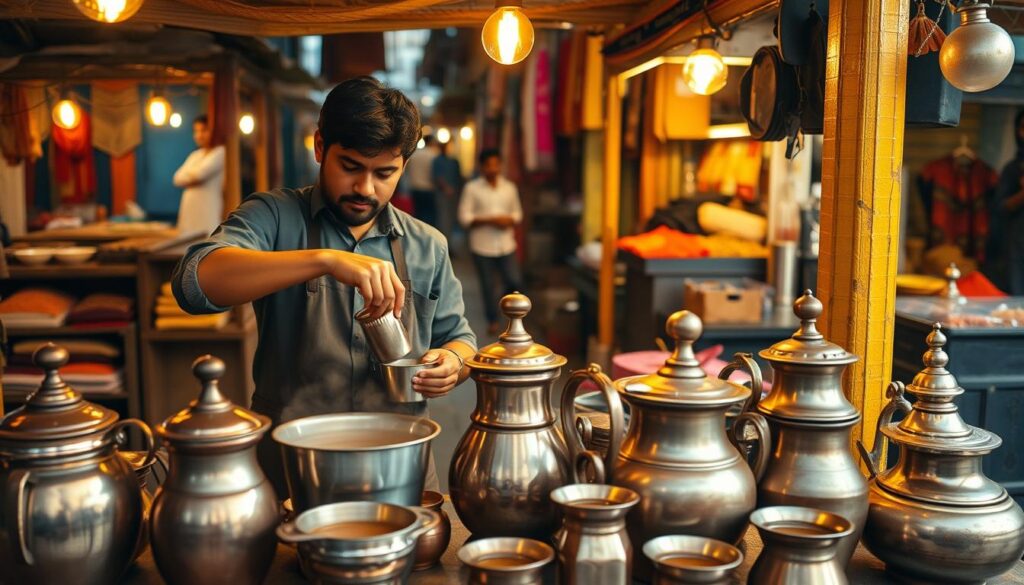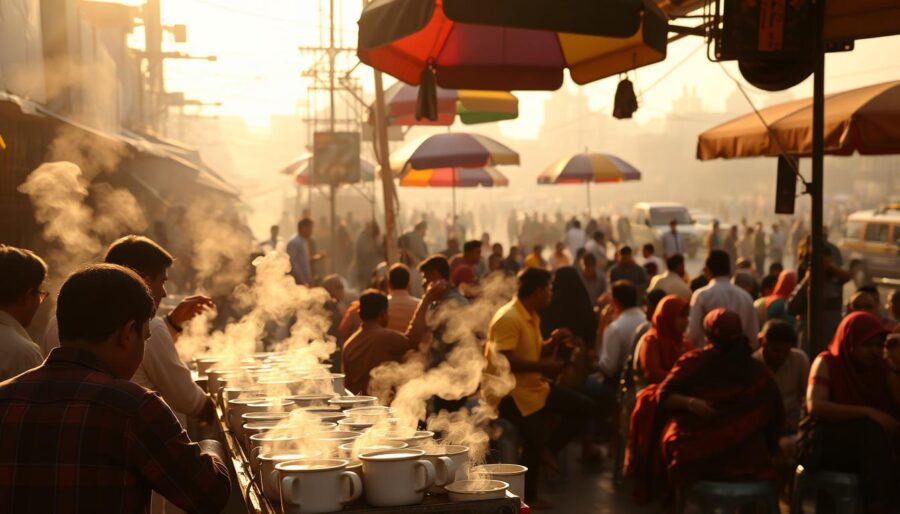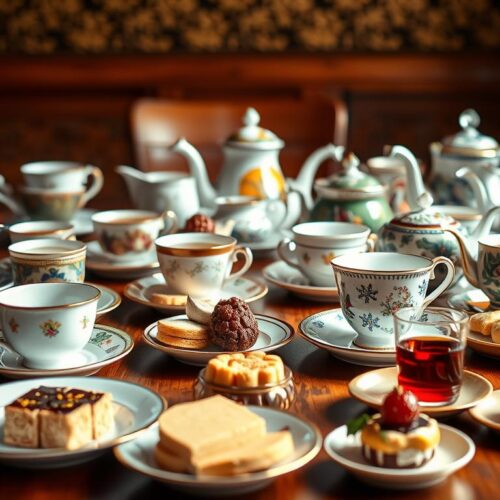In the busy streets of India, the scent of fresh masala chai wraps around you. It’s like an invite to join in a deep-rooted tea tradition filled with culture. Among the noise and rush, Indian chai stands out not just as a drink but as a key link between people, offering warmth and welcome.
Every cup of chai builds connections and starts talks, showing the wide range of human stories.
When you sip this beloved drink, remember that chai is more than just tea. It carries stories, customs, and a deep feeling of togetherness, making it a vital part of chai culture’s story. See how this favorite drink unites folks, creating moments of togetherness and happiness in daily life.
The Origins of Indian Chai Culture
Indian chai has a rich history that goes back centuries. Originally, tea was first grown in ancient China. Over the years, tea culture made its way to India and became what we now call chai.
The British colonial era changed chai’s history a lot. The British started growing tea in India, which led to big plantations. At first, only the rich could afford tea. But soon, everyone started enjoying it with spices and milk. This mix turned into the spiced drink loved in Indian homes today.
Chai is more than a drink in India; it’s a part of the culture. It shows the country’s rich traditions and diversity. Nowadays, chai is a must-have drink for many. Its story is about adopting a foreign drink and the toughness of Indian people.
The Ingredients That Make It Unique
Exploring the key chai ingredients helps us appreciate Indian chai’s rich culture. At the core sits strong black tea, the backbone of its bold taste. Adding to this are several tea spices, all offering their distinct smells and health benefits.
Here’s what’s typically inside:
- Cardamom: Famed for its intense scent and sweet taste.
- Cloves: They bring a cozy, spicy touch that boosts the chai’s depth.
- Cinnamon: This adds a sweet warmth and can be slightly bitter.
- Ginger: Fresh ginger provides a sharp zest, awakening the senses.
- Black Pepper: It’s an unusual pick that brings a tad of spice.
When these tea spices mix, they form a flavor orchestra. This makes every sip of masala chai more than just a drink; it’s a feast for the senses. The mix of milk and sugar tones down the spice, offering a creamy and smooth taste.
Different regions in India tweak these spices and their amounts, showing off local tastes and traditions. This variance in chai ingredients emphasizes India’s vast culinary art, making each area’s version of this adored drink unique.
| Ingredient | Flavor Profile | Health Benefits |
|---|---|---|
| Cardamom | Sweet, aromatic | Digestive aid, anti-inflammatory |
| Cloves | Warm, spicy | Loaded with antioxidants, fights microbes |
| Cinnamon | Sweet warmth | Controls blood sugar, reduces inflammation |
| Ginger | Zesty, spicy | Calms upset stomachs, lowers inflammation |
| Black Pepper | Sharp heat | Boosts digestion, improves nutrient uptake |
How Chai is Prepared
Making chai turns simple ingredients into a heartwarming drink. It’s an art seen mainly at busy tea stalls. These stalls show off the chaiwalla’s skills. Every cup of chai not only tastes great. It also shares traditions and the chaiwalla’s special touch.
When you get closer to a chai stall, you’ll hear boiling water and the sound of glasses. The chaiwalla carefully mixes water, milk, tea leaves, and spices. They’ve done this many times. The boiling mix with spices like cardamom, ginger, and cloves smells welcoming. It makes people want to stop and try a cup.
Every chai tells its own tale and shows a bit of the local way of life. Chaiwallahs add their unique spin, making each cup one of a kind. They play with sugar and spice to get the taste just right. Chai lovers really value these special flavors.
Chai making often includes straining out the leaves for a smooth drink. A little extra spice or sugar at the end makes it even better. Drinking artisanal chai is a cherished tradition. It brings people together, creating moments of friendship and shared enjoyment.

The Social Aspect of Chai
Chai is more than just a drink in India; it’s a key way people connect. At chai gatherings, everyone shares stories and talks over hot chai. These times help people become closer, with both friends and new people.
Tea rituals make everyone feel like they belong. Families or groups often meet early in the morning or late at night. They enjoy the warm chai together, which can turn strangers into friends quickly.
Chai is also important during special times like festivals. Sharing communal tea makes these moments better and brings people closer. Whether it’s Diwali, Holi, or just a casual meeting, chai unites everyone in celebration.
Chai in Everyday Life
Chai is a big part of life in India, being much more than a simple drink. It is found in the daily routines and social moments. It starts with the smell of chai in the morning and ends with enjoying it with family at night.
Making chai is a special time in many homes. While the tea brews, families come together to share stories. It creates a warm environment, bringing everyone closer.
Chai changes depending on where you are in India. In the north, masala chai with spices keeps people warm. In the south, they might add coconut milk, making a lighter version. Each style shows local tastes and ingredients.
Chai also plays a big role in social life. It is offered at roadside stalls and gatherings, starting conversations. It brings people together, no matter their background. This drink is a true symbol of companionship and joy.
The Health Benefits of Chai
Drinking chai is more than enjoying a tasty drink; it’s also about boosting your health. Its special mix of spices offers outstanding benefits for your well-being. Ingredients like ginger and cardamom bring antioxidants and fight inflammation. This makes chai not just delicious, but also a great natural booster.
Chai is great for your digestion, thanks to ginger. This spice eases stomach upsets and enhances how you digest food. Chai’s caffeine keeps your mind sharp, perfect for an afternoon pickup. Plus, it can make you feel more at ease. Its soothing smell and warmth can help you relax and feel better.
Here’s what makes chai good for you:
| Health Benefit | Description |
|---|---|
| Aids Digestion | Ginger helps in reducing nausea and soothing digestive issues. |
| Enhances Mental Alertness | Caffeine content provides a natural boost to cognitive function. |
| Offers Antioxidant Protection | Spices contain antioxidants that help combat oxidative stress. |
| Promotes Emotional Comfort | The warm nature of chai can help reduce stress and promote relaxation. |
Chai helps you in many ways, making it a wonderful tea for everyday drinking. Adding chai to your life supports your body and mind. It’s more than a drink; it’s a full experience for better health.
Chai and Its Global Influence
Chai’s influence has grown, becoming a key part of global chai culture. It began in India and has spread to cafes and homes worldwide. Now, chai shows different versions that suit local tastes, such as chai lattes.
In various countries, chai takes on unique forms that show off cultural tastes. For example, chai in Australia focuses on traditional spices and sustainability. In the United States, it’s mixed with flavors like pumpkin spice or matcha. These versions show how chai is always changing and appealing across cultures.
Chai has become more than a drink; it’s a symbol of community and cultural connection. Its spread from India to the world highlights how a simple drink can bring people together. Sharing chai fosters connections and conversations across different cultures.
The Role of Chai in Indian Festivals
Chai is very special during Indian festivals, making the celebrations feel more cultural. When families and friends come together, making and sharing chai turns basic moments into precious memories. Each festival, like Diwali, Eid, or Holi, has special rituals with chai, making it key to Indian traditions.
In Diwali, the Festival of Lights, chai means warmth and welcoming. Families invite guests over for sweets and snacks with hot chai. This act creates a feeling of unity and happiness, making every meetup more special.
Eid also highlights chai during its feasts and customs. Offering chai to guests is a sign of kindness, helping strengthen bonds with family and the community. The special mix of spices in the tea reflects the celebration’s spirit, making gatherings warmer.
During Holi, the festival of colors, chai gets a fun twist. People make flavored chai, adding local ingredients to match the festival’s joy. This shared chai boosts the festive mood and connects everyone involved.
Chai brings people together in Indian festivals. Its role in these important events highlights hospitality, community, and unity in Indian culture. Enjoying chai is a tradition passed down, inviting all to share moments that feed the soul and body.
Artisans and the Craft of Chai
The art of making chai is a true craft. It shows how dedicated the makers are. Many don’t see that each chai cup reflects the maker’s skill and love. From the street vendors known as chaiwallahs, to local tea makers, each has a special touch. They make blends that honor traditional recipes but also add something new.
Finding the right ingredients is key to making artisan chai. Artisans pick fresh spices, top-notch tea leaves, and milk from local sources. They pay close attention to every detail, making sure each part boosts the flavor. The way they brew it is also crucial. Getting the timing and temperature right brings out the best flavors. This makes for a rich, aromatic drink.
Serving chai is also about the culture. Artisans serve their chai with a lot of care. This turns a simple drink into a real experience. How chai looks when it’s served can make it taste and feel better. Artisans keep coming up with new ways to serve it. They use either traditional clay cups or fancy modern glassware. This helps chai culture keep growing.
These artisans are keeping chai culture alive while making it fit today’s tastes. They stick to old methods but also try out new flavors. This helps people all over the world love this special drink even more. Their work adds to the colorful world of chai making.

Chai and Sustainability Concerns
In recent years, the conversation around sustainable chai has gained momentum. The global growth of chai production highlights the need to consider its environmental effects. Practices such as deforestation, soil damage, and water scarcity have become major concerns.
These issues urge a move towards greener methods. Doing so not only safeguards our planet but also improves the tea’s quality. This shift is crucial for the future of chai.
Now, many brands focus on ethically sourcing ingredients. This ensures that chai production benefits the communities involved fairly. By picking products from such companies, you help promote responsible farming. Always check for Fair Trade or organic labels when choosing your chai.
There are efforts to make chai production more eco-friendly. For example, farmers are mixing trees into their tea gardens, known as agroforestry. This approach boosts biodiversity and cuts down carbon emissions. It enables the production of top-quality tea while caring for the soil and saving water.
So, when you sip your next chai, think about the impact of choosing sustainable brands. Your decisions can greatly influence the chai industry. They support a move towards a greener future that’s good for both people and our planet.
Future Trends in Chai Culture
The future of chai looks very promising as people worldwide enjoy different drinks. There’s a rise in creative chai trends, from the traditional to new versions for health-focused folks. This growing chai culture blends old traditions with new practices.
Chai-flavored snacks and desserts are becoming more popular in many places. Companies are mixing new flavors and ingredients, making chai more than just a drink. Healthier chai options with organic and natural ingredients are also becoming popular.
Technology is key in shaping how we enjoy chai. Online platforms and social media are changing the way chai is shared and enjoyed. Look forward to new brewing methods and smart appliances that simplify chai preparation. This mix of the old and new shows chai’s enduring appeal and its ability to evolve.




